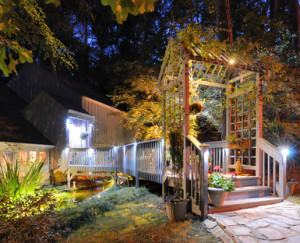What are Common Lighting Issues?
Posted on December 13, 2013
House exterior with porch walkay over a pond and lighting in the woods
Outdoor lighting can beautify a property, add to its safety and security, and extend the enjoyment of the outdoors well into the night. However, if the landscape lighting system doesn’t work, then none of these aspects can be achieved. Depending on the quality of the system that was initially installed, there can be a few or many common lighting issues that can and will occur over the lifetime of a lighting system, and severity can range from a burned-out light bulb to fire-hazard situations.
Typically, the most common lighting issue is a light bulb that has gone out. If the light has burned out, it is a simple fix and only takes a few moments to replace the old bulb with a new one. A light could also go out because of a bad connection. It’s only a matter of tracking down the bad connection and repairing or replacing it. Also, a light could go out because the socket has become corroded. The most responsible repair for a lighting professional in this situation is to go ahead and replace the light fixture.
Another common lighting issue is some or all of the lights are out. This is usually indicative of an electrical short. A quick and easy solution is if the ground fault interrupter (GFI) has tripped a breaker and simply needs to be reset. (What is a GFI? https://www.homeadvisor.com/article.show.Ground-Fault-Interrupters-Keep-up-the-Code.14182.html). Another quick and easy solution is that the clock timer or photo sensor have been improperly set, causing the lights to come on at incorrect times. Also, the lights could be out due to high levels of amperage exiting the transformer. In this situation, amperage on each fixture can be tested to narrow down the location of the short.
Sometimes bulbs seemingly become dim. This is a symptom of improper voltage at the light fixture. Every extra light added to a landscape lighting system and every added foot of wire, leads to voltage drop. If the connections are not watertight, there will be even more voltage drop. Perhaps there is too much demand on the transformer and another transformer needs to be installed to power all of the lights. According to VOLT, a landscape lighting supply store, voltage drop is one of the five most common mistakes made while installing landscape lighting. (https://www.landscapelightingworld.com/Top-5-Low-Voltage-Outdoor-Lighting-Installation-Mistakes-a/162.htm)
Overtime, connections can be pulled tight and even pull apart. It is good practice for a lighting professional to leave extra wire near connections (keep it slack) so that as the ground expands and contracts, or as trees grow taller, or as shrubs grow out, there is enough wire to be pulled. If the connections are too tight to begin with, as time goes by, these connections will undoubtedly fail.
One easy thing that a homeowner can do to steer clear of avoidable repairs is to be careful when working in the garden or lawn. It is in the best interest of the homeowner to review the outdoor lighting plan for their property and to take a close look at their garden and lawn before digging to ensure that the wires on the plan are in fact located in the same spot outside. Avoiding a cut wire can save the homeowner money on a service call. In addition, keeping shrubs trimmed around lights will ensure that the light is not interrupted and reaches its intended target.
Leave a Reply
You must be logged in to post a comment.
There are no comments on this entry.